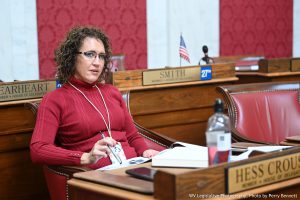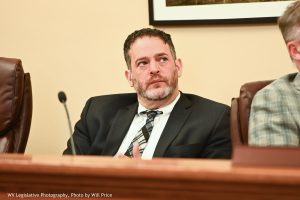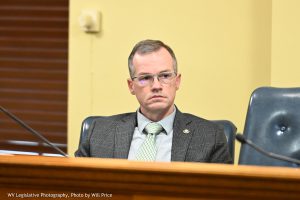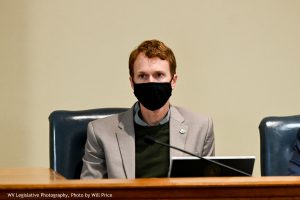In December, members of the Joint Committee on Health heard presentations from Mark Drennan, the Chief Executive Officer, WV Behavioral Healthcare Providers Association, regarding the “Involuntary Commitment Process” and Mental Hygiene.
Mental Hygiene, interchangeably referred to as involuntary commitment, civil commitment or commitment, is the civil court process by which someone, who due to mental illness, can be placed (and secured) involuntarily in a treatment facility for mental illness.
Generally, how the process works is as follows: Application Filed; Petition Accepted; Pick-up Order – Transportation Event; Mental Hygiene Examination – Possible Transportation Event; Hearing – Transportation; and Placement at a Facility – Transportation. As you can see, several of the steps may or do require transportation.
The biggest issues involving this issue currently are the timeliness of the process, a lack of uniformity, medical clearance, and transportation.
On the first issue regarding the timeliness of the process, there is consensus among the stakeholders that improving the timeliness of the process will alleviate some of the complaints from the various parties. There are places in the process that, if modified, will improve the efficiency and therefore the timeliness of the process.
 On the lack of uniformity, one major complaint from stakeholders is that the process is different from county to county and circuit to circuit. For example, in Raleigh County, the mental health center meets with the petitioner prior to its filing, explains the process and walks the petitioner through it. If this example was implemented statewide, the stakeholders believe this will reduce the number of applications that are filed as petitioners become aware of other voluntary options.
On the lack of uniformity, one major complaint from stakeholders is that the process is different from county to county and circuit to circuit. For example, in Raleigh County, the mental health center meets with the petitioner prior to its filing, explains the process and walks the petitioner through it. If this example was implemented statewide, the stakeholders believe this will reduce the number of applications that are filed as petitioners become aware of other voluntary options.
Another example of the lack of uniformity is the definition of forthwith from the law. Some counties wait until the next business day for hearings. Many times, this causes deputies to maintain custody until the day of the hearing. Commonly defined, forthwith means immediately or without delay.
One final example of a lack of uniformity relates to 72-hour holds. This can be done now in a hospital with those capabilities but applying to the entire process begs the question about the urgency of the case. It reverses the part about the importance of forthwith hearings. This is again in relation to individuals who are an imminent danger to themselves or someone else. They need attention now or someone might get hurt.
Next, regarding transportation, transportation issues are significant. Transporting individuals for assessment and possible commitment tie up the limited resources and time of sheriff deputies across the state. There is a lot of unnecessary waiting time. Anything that can be done to reduce the amount of time required for decision-making and intake would help tremendously.
The stakeholders have come up with some possible solution to transportation issues: Adding municipalities to aid the Sheriffs in transportation; Adding the ability of EMS to transport after disposition; Improving the efficiency of the process at each step and streamlining the medical clearance process; and if mental health centers adopted the Raleigh County practice of meeting the petitioner before the filing.
The committee planned to hear more from the stake holders in preparation for the 2022 Regular Session.
Legislative Oversight Commission on Health and Human Resources Accountability
The committee heard a presentation on Nurse Innovation and Entrepreneurship. There are currently over five million nurses in the United States. The average age of nurses is 50 years old with 70 percent of nurses being over the age of 40. Currently, nursing is experiencing the larges exodus of any profession in the US. It’s a crisis, because the reality is that nurses are the foundation of the health care system. Nurses are experiencing trauma and burnout which is leading to turnover. Over 50 percent of nurses feel undervalued. Today, health care is so dark. There is opportunity to uses nursing innovation to create change.
 The committee also heard from a foster parent on her thoughts of the Foster Care System. She stated that becoming a foster care parent has been an eye-opening experience. She’s experienced a breakdown of communication with all different entities. She stated there is not enough support for the foster care families. She noted delays in receiving information about placements and continuously receiving information for children who are no longer in her care. She also noted that there was an error that listed her as fostering a child she had never been given care of. She knows she has no legal right to know what happens to a child once he/she has left her care but would like an outlet or network to connect with others with similar situation. She stated the system must be updated to provide better communication.
The committee also heard from a foster parent on her thoughts of the Foster Care System. She stated that becoming a foster care parent has been an eye-opening experience. She’s experienced a breakdown of communication with all different entities. She stated there is not enough support for the foster care families. She noted delays in receiving information about placements and continuously receiving information for children who are no longer in her care. She also noted that there was an error that listed her as fostering a child she had never been given care of. She knows she has no legal right to know what happens to a child once he/she has left her care but would like an outlet or network to connect with others with similar situation. She stated the system must be updated to provide better communication.
The committee also heard the final report from the Tobacco Use Prevention and Cessation Task Force. The Task Force was formed in 2020 when HB 4494 was passed to recommend programs effective at reducing tobacco use by WV citizens.
Joint Standing Committee on Education
The Education Committee heard a presentation on the higher education funding formula and governance structure. This presentation continued from November interims. Bluefield State College President reported that there are several high demand programs including surgical tech, engineering tech and 12 health science programs, seven of which are not offered regionally. Bluefield state wants and as the capability of offering these programs.  However, without special permissions from CTCs in the region, the school cannot offer the program. The president is frustrated with this because WVU, Marshall, WVU Tech, and out of state online schools can offer programs in this region without these special permissions. The president stated that there have been several reasons brought forth to keep the school from offering these programs including competing with other schools in the region, however other schools are not offering these programs. Financial viability was another reason. Bluefield State has the second-best CFI in the state. The president believes a new higher education model with a focus on education and not power and protecting turf is needed. He said the structure should be based on competition and not command and control in bureaucracy. The new structure should allow schools to innovate, create, and respond to the needs of students and employers. He stated some concerns others have had with a model such as this including the institutions failing and coming to the legislature and asking for more money. His response to that was let them fail. Another concern he mentioned was closing institutions will leave students without opportunity. His response was that if there is a demand for these programs and these schools, then they will not fail and they will not need to be closed.
However, without special permissions from CTCs in the region, the school cannot offer the program. The president is frustrated with this because WVU, Marshall, WVU Tech, and out of state online schools can offer programs in this region without these special permissions. The president stated that there have been several reasons brought forth to keep the school from offering these programs including competing with other schools in the region, however other schools are not offering these programs. Financial viability was another reason. Bluefield State has the second-best CFI in the state. The president believes a new higher education model with a focus on education and not power and protecting turf is needed. He said the structure should be based on competition and not command and control in bureaucracy. The new structure should allow schools to innovate, create, and respond to the needs of students and employers. He stated some concerns others have had with a model such as this including the institutions failing and coming to the legislature and asking for more money. His response to that was let them fail. Another concern he mentioned was closing institutions will leave students without opportunity. His response was that if there is a demand for these programs and these schools, then they will not fail and they will not need to be closed.
The WVDE Technical Education Officer presented on the adult education services offered in West Virginia. He stated that adult education has a huge impact on the state. The purpose of adult education is to learn soft employment skills, provide parent education, GED course, and citizenship courses. Adult education services are free. There are 92 locations around the state and every county has multiple locations. All instructors are certified teachers. Adult Education programs work with Workforce WV to help train students for the workforce. It has also started partnership with Community Colleges. The program offers a rigorous math course which gives students three community college credits. Landau Eugene Murphy Jr. has partnered with Adult Education to spread the awareness that it is never too late to graduate.
The committee also heard a presentation about the need of athletic trainers in high schools. Athletic trainers can help identify the best way to handle an injury or illness with athletes. Being present during sporting events allows the trainer to witness exactly how the injury happened and what needs to happen next. In WV, only 50 out of 115 high schools employ athletic trainers. After football season. only 35 school employee athletic trainers. This means 15 schools’ employee an athletic trainer only for football. There is no policy that mandates an athletic trainer for female sports.
Legislative Oversight Committee on Education Accountability
 The committee heard a presentation on the WV Invest Grant Program. It was presented that CTCC have allowed super-scoring where students may use their best scores on the ACT to meet the requirements of the promise scholarship. The program also offers a stem field grant. There is a revolving medical school fund program which come from student fees. This helps provide funding for medical students. The Choose WV Practice Program is for out of state medical students to entice them to come to WV for schooling. The fund pays the difference of out of state and in state tuition.
The committee heard a presentation on the WV Invest Grant Program. It was presented that CTCC have allowed super-scoring where students may use their best scores on the ACT to meet the requirements of the promise scholarship. The program also offers a stem field grant. There is a revolving medical school fund program which come from student fees. This helps provide funding for medical students. The Choose WV Practice Program is for out of state medical students to entice them to come to WV for schooling. The fund pays the difference of out of state and in state tuition.
The 2021 WV Financial Aid Comprehensive Report was presented. The update included students receiving aid would only be drug tested once a year instead of semester to help save the state the cost of drug testing. If a student test positive for drugs, they are not turned away. They are provided counseling and treatment.
The Joint Legislative Committee on Flooding met in December to hear an update on the projects within the Rise WV program from officials representing the Community Development Block Grant for Disaster Relief program and the West Virginia Development Office.
During questioning from one senator the officials confirmed this week that West Virginia is under an investigation related to its longstanding flood relief efforts, but the elements of the investigation were not revealed during the committee.
The official described recent progress with the demolition program for houses that were determined to be unlivable following the massive 2016 flood across much of Southern West Virginia. She also mentioned that issues like duplication of benefits, which has since resulted in a corrective action plan following routine monitoring from Federal U.S. Housing and Urban Development.
Following the 2016 flood, West Virginia received $149 million in relief from U.S. Housing and Urban Development.
 Later in the meeting the committee also heard a report regarding the $106.5 million which was received in Community Development Block Grant-Mitigation (CDBG-MIT) funding from the U.S. Department of Housing and Urban Development. West Virginia received approval to spend the money back in January 2021.
Later in the meeting the committee also heard a report regarding the $106.5 million which was received in Community Development Block Grant-Mitigation (CDBG-MIT) funding from the U.S. Department of Housing and Urban Development. West Virginia received approval to spend the money back in January 2021.
The CDBG-MIT funds are required to be used for projects which lead to reduced flooding, reduce the impact of future natural disasters and reduce the risks associated with floods to people and properties.
As part of the grant, the funds can only be applied in the 12 counties affected by the 2016 flood: Clay, Greenbrier, Kanawha, Nicholas, Fayette, Jackson, Lincoln, Monroe, Pocahontas, Roane, Summers, and Webster counties. Also, the state must spend 50 percent of the CDBG-Mitigation funds within the first six years, and fully expend the funding in 12 years. Of the usage, half must be spent on projects to benefit low-income and moderate-income persons.
For the first round of funding, the state received 37 applications and approved 18 of those. Among those projects were nine stormwater projects, two water treatment plants, two dam projects, one sanitary sewer relocation projects, and four planning projects. The total cost for the 18 approved projects was $65 million.
The state is accepting applications for projects in 2022 for the remaining $40 million in funding. The state is also working with prior applicants who were rejected to see if there were simple errors in their applications in order to help them qualify.
Finally, the committee heard from the new director of the State Resiliency Office. Mr Rob Martin is the second State Resiliency Officer since the program was created by Senate Bill 586 in 2020 after discussions between Gov. Jim Justice and the Flood Committee.
He explained that the State Resiliency Office works with state agencies to ensure that parts of the state hit with natural disasters and man-made emergencies can bounce back quickly. It also manages non-federal disaster and hazard mitigation grant funding. The office is assisted by an advisory committee of state cabinet and constitutional offices as well as other state agencies and legislative appointees.
In recent years his office has worked on the Milton Flood Wall Risk Management Project and on the RISE West Virginia Community Development Block Grant-Disaster Recovery program.
Joint Standing Committee on the Judiciary
The committee heard presentations on criminal justice reform. Several states are experiencing the same issue of overcrowding that WV is, including Texas, Tennessee and Kentucky. In 2007, Texas faced an overcrowding crisis in the prisons and decided the state was not going to build its way out of the problem. The state worked to safely due reform and draw doing prison population. From 2017 to 2019, the incarceration rate dropped from 153,661 to 121,128. Texas has closed 11 adult prisons. The parole revocation dropped 3.9 percent in 2020 and the felony probation revocation rate dropped 11.3 percent. As the incarceration rate dropped so did the state’s violent crime rate. The crime rate declined by 39 percent to the lowest rate since the 1960s. The state’s three-year recidivism rate has dropped by 39 percent. Texas reform also includes pretrial reform. The state passed the Damon Allen Act, named for a state trooper who was killed by someone out on bail. The reform includes mandating magistrates review criminal history before setting bail and increasing training to help them properly assess the offender’s history. It also prohibits personal bond for someone who is violent or a reoffender.
 Tennessee raised the felony theft threshold and required the DOC to implement a validated risk of needs assessment tool. The state also implemented “graduated sanctions,” which allows the supervising parole or probation officer to handle sanctions instead of forcing the person to go back to court. It also allows for credit for time served on probation. The state is focusing on reentry and making parole more meaningful. Tennessee has legislative studies underway to examine pretrial reform. Many counties have implemented a pretrial risk assessment tool. The governor supports the use of this tool. There are drafted bills for reform.
Tennessee raised the felony theft threshold and required the DOC to implement a validated risk of needs assessment tool. The state also implemented “graduated sanctions,” which allows the supervising parole or probation officer to handle sanctions instead of forcing the person to go back to court. It also allows for credit for time served on probation. The state is focusing on reentry and making parole more meaningful. Tennessee has legislative studies underway to examine pretrial reform. Many counties have implemented a pretrial risk assessment tool. The governor supports the use of this tool. There are drafted bills for reform.
In West Virginia, there are 6,500 sentenced and 4,000 released each year. The rearrest rate in 3 years in 30 percent. The annual cost per inmate is $32,444. The state can simultaneously reduce prison population and improve public safety. The state should reserve prison beds for those who pose a threat to public safety and invest in alternative sentencing programs for those who do not pose a threat to public safety. Fifty-one percent of the WV jail population are pretrial detainees. It cost $55 per day to house each of these pretrial detainees. Of the pretrial detainees, 556 are for misdemeanors and 1,979 are for felonies. Some need to be held because they are a threat to the public or a flight risk. There needs to be a risk-based assessment to determine if a person is low, medium, or high risk. West Virginia will be a full0time Right-On Crime state soon.
The committee also heard a presentation on the Clean Slate Initiative. It was presented that one third of West Virginians have some sort of criminal record. A decade old minor offense can affect housing and jobs. Having a clean slate can help prevent a person from reentering into the prison system. The clean slate act helps expunge misdemeanors and non-violent offenses. Without this program there is Second Change gap. The Clean Slate Initiative would use technology to determine who’s record could be cleaned. Clean Slate Laws have been adopted in PA, NJ and other states. Half of the children in the US have a parent who has a criminal record. Clean slates enhance workplace development, reduce the rate of recidivism, and improve public safety. The economy takes a hit when people with records are not hired. They are frequently the first fired and last hired. The Clean Slate Initiative is a national bipartisan program.
An effective criminal justice system protects people and preserves public safety, respects human dignity, restores victims, removes barriers to opportunity for people with criminal records, and ensure equal justice for all under law. Five areas that need reform are overcriminalization, policing, due processing, sentencing, and prisons and reentry.
Joint Committee on Children and Families
 The committee heard a presentation from DHHR on Neonatal Abstinence Syndrome (NAS). NAS is when a baby experience withdrawal from drugs after being born. In 2021, WV had 18,072 births and 6.55 percent, or 1,200 babies, were born with NAS. Of the 18,073 births, 14.2 percent of the babies were drug exposed, meaning not all showed withdrawal symptoms, but mothers did use during pregnancy. In West Virginia, drug use, child welfare cases, and NAS are all increasing. Most of these mothers are young (under 25), unmarried and uneducated. Fatal overdose rates are increasing because of the use of fentanyl in various drugs. It is sometimes difficult to determine what the baby is withdrawing from because the mother is unaware that the drugs she is using is laced with other substances.
The committee heard a presentation from DHHR on Neonatal Abstinence Syndrome (NAS). NAS is when a baby experience withdrawal from drugs after being born. In 2021, WV had 18,072 births and 6.55 percent, or 1,200 babies, were born with NAS. Of the 18,073 births, 14.2 percent of the babies were drug exposed, meaning not all showed withdrawal symptoms, but mothers did use during pregnancy. In West Virginia, drug use, child welfare cases, and NAS are all increasing. Most of these mothers are young (under 25), unmarried and uneducated. Fatal overdose rates are increasing because of the use of fentanyl in various drugs. It is sometimes difficult to determine what the baby is withdrawing from because the mother is unaware that the drugs she is using is laced with other substances.
WV is committed to Children’s Mental Health Services. DHHR is looking to better serve children with serious emotional disorders or serious mental illness. The Children’s Crisis and Referral Line connects family and youth with crisis and non-emergency behavior health services in their community. The call line has been operational for a year and 48 percent of callers have been from a child’s loved one, while 34 percent were from the youth in need. Most (92 percent) of the “calls” were via chat or text.
West Virginia Wraparound is a service provided to families with a child with serious mental health and behavioral challenges. A person is provided to the family to help identify the needs of the child and the family to create a plan for them. Treatment homes will be an alternative to a residential placement for foster children requiring a behavior health intervention. Theses short-term interventions will provide a stable family-like setting with treatment and behavioral intervention so the child can return to their home or other family setting.
The Committee received an update on CPS. The state has about 400 CPS workers. The state’s vacancy rate has increased from 19 percent to 17 percent for CPS workers. The district of Calhoun, Jackson, and Roane has a 43 percent vacancy, while McDowell has a vacancy rate of 50 percent. The Adoption unit has a vacancy rate of 33 percent and the home finding unit’s rate is 19 percent. The crisis response team has no vacancies, while the centralized intake has a vacancy rate of 15 percent. The bureau is reorganizing district by judicial districts. CPS intake calls are now being recorded.

